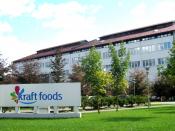Kraft come a long way since J. L. Kraft started selling cheese from a horse-drawn wagon in 1903. Hard work, imagination and a commitment to bringing the world its favorite foods have helped it grow into a company that touches more than a billion people in 151 countries. Every day. One at a time.
Kraft is structured along three dimensions, aligned with their global consumer sectors - beverages, cheese and dairy, convenient meals, grocery and snacks - and focused on working closely with each other.
Kraft is one of the superdistributors. It sells a full line of foodservice products including, in addition to food, kitchenware, paper products, chemicals and equipment. The national fast food chains value kraft's national coverage because they can designate it as their primary supplier nationwide and be sure of consistent product and service quality. Through a sophisticated management information system linking headquarters and the branches and permitting direct order entry by its customers, it can minimize the inventories in its system, optimize the routing of the trucks, and provide product usage reports to the customers.
Kraft didn't aim to be a product innovator in foodservice but to use its distribution muscle to bring an improved version to market before the innovator took hold.
The foodservice industry included a variety of commercial and noncommercial operators who purchased products from foodservice distributors and in some cases direct from food manufacturers. Most operators preferred to deal with more than one distributor. A 1980 survey found that foodservice operators in Dallas purchased from an average of six distributors, but the half of the purchases was typically made from the principal distributor. The distributors were selected on the basis of price, delivery speed and reliability. Outside the United States Kraft was the third largest foodservice operation in sales. Despite being a...


